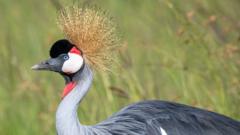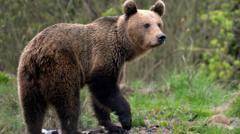With a storied past entwined in Uganda's culture, the crested crane is now threatened by declining populations and human encroachment. Conservation efforts are underway, but challenges persist as farmers view the bird as a pest rather than a national treasure.
The Crested Crane Crisis: Uganda's Beloved Symbol Faces Extinction

The Crested Crane Crisis: Uganda's Beloved Symbol Faces Extinction
Uganda's iconic crested crane, an emblem of national pride, is on the brink of extinction due to habitat loss and agricultural conflicts.
The crested crane, renowned for its striking golden crown and slender figure, holds a cherished place in Uganda's identity, depicted on the national flag and coat of arms. However, this iconic bird is facing a significant risk of extinction, as conservationists sound alarms about its dwindling population and the dire need for protective measures.
Historically, the crested crane has been revered in local culture, with deep-rooted superstitions preventing its killing, viewed instead as a lucky symbol. Jimmy Muheebwa from Nature Uganda notes the cultural reverence that once protected these birds has faded, leaving many Ugandans unaware of the legal implications of harming them.
Recent shifts in agricultural practices have heightened tensions between farmers and the cranes. Farmers complain that the birds forage in their fields, consuming valuable crops and threatening food security. “I see no value in these birds,” stated Tom Mucunguzi, a maize farmer, highlighting the growing perception of cranes as pests rather than cherished wildlife.
Once thriving in wetlands across Uganda, the crested crane's habitat has been systematically encroached upon due to escalating human activity. Adalbert Ainomucunguzi from the International Crane Foundation reported a staggering decline of over 80% in eastern Africa's crane population over the past quarter century, shrinking from over 100,000 individuals in the 1970s to a mere 10,000 today. This worrying trend prompted the International Union for Conservation of Nature to classify the species as endangered.
Human-induced threats compound the challenges for the crested crane. Reports of cranes being poisoned by farmers as a deterrent against perceived crop damage have surfaced, drawing attention to the need for alternative bird control measures like scarecrows. On a broader scale, high mortality rates linked to habitat destruction and land use changes paint a grim picture.
As the Ugandan government, alongside conservation groups, seeks to reverse these trends, they are urging community engagement in wetland restoration efforts. President Yoweri Museveni has proclaimed 2025 a “Year of Wetland Conservation,” underscoring the commitment to protecting the cranes' dwindling habitats.
However, while public awareness campaigns and grassroots conservation initiatives are underway, challenges remain. The crested crane’s intriguing yet vulnerable nature—characterized by their lifelong pair bonds—compounds their susceptibility to extinction. The population's unique biological and behavioral traits, such as monogamous pair bonding and site fidelity for breeding, make them particularly vulnerable to habitat disruption.
While conservationists remain optimistic, underscoring the positive impacts of current restorative measures, many believe immediate, concerted actions are vital to stave off potential extinction. Ultimately, the fate of the crested crane hangs in the balance, and its iconic status as Uganda’s national bird underscores the urgent need for collaborative efforts between farmers, communities, and conservationists to forge a sustainable future for this avian symbol of grace.





















